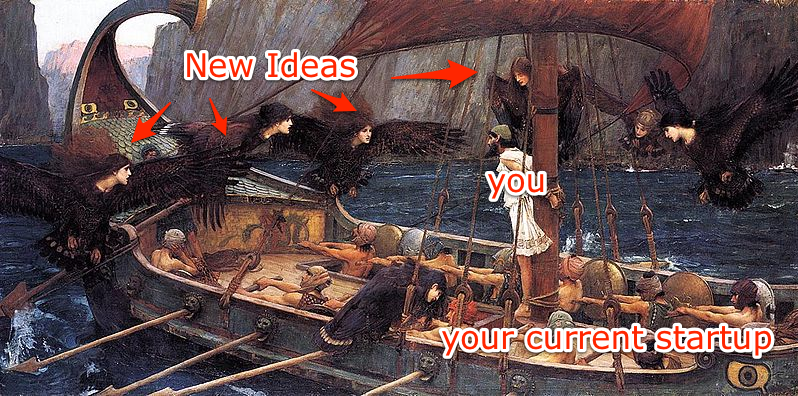Guide to Finding a Technical Co-Founder
September 7, 2010 | Comments | co-founder, startups
Vinicius Vacanti is co-founder and CEO of Yipit. Next posts on how to acquire users for free and how to raise a Series A. Don’t miss them by subscribing via email or via twitter.
“I’ve got this HUGE idea. I just need to find a technical co-founder.” Ugh. I’ve heard that too many times over the last few years and it almost always ends badly.
I was in this situation and we barely escaped. I write this post to put you out of your miserable technical co-founder search and give you some realistic options.
The Challenge of Finding a Technical Co-Founder
To find a great technical co-founder, you need to convince them of the following:
- Your idea is better than all of their ideas
- The equity is worth spending all of their spare time working for no money
- You are worth 50% of the equity of the company
- You will execute and convert an idea into a big successful business
- You’re better than all of the other biz people pitching them
This is a pretty daunting list. You see, good technical co-founders are like the attractive people at the dance. They’re hot, they know it, everyone wants to sleep with them, and they can also go home and sleep with themselves (the analogy got a little weird there, sorry). So, why should they pick you?
Your Options
Here are your options for finding a technical co-founder. Notice how little control you have over most of them.
- College Roommate or Co-Worker. Your best bet by far is if you have personally known someone for a while and preferably worked together. They are the ones that know you well enough to believe what you are capable of. If you don’t have someone like this, and most of you don’t, you’re in big trouble.
- Have Experience. If you have already started a successful start-up, you’re probably not reading this post because your struggling to find a technical co-founder; you have your pick.
- Have Domain Expertise. You’re starting a new photo sharing site and you were the project manager for Facebook’s photo app; you’re starting a music label disruptor and you worked for a music label for the last five years. As a personal example, when we told people Yipit was going to be a Kayak for the Daily Deal industry, we would have been way more convincing if we had actually worked at Kayak.
- Traction (the Catch 22 option). This is the only one you can, in theory, control. You’d have a lot easier time getting a great technical co-founder to join you if your initial prototype had 20,000 users and growing. Unfortunately, it’s a bit of a Catch 22 in that you sort of need a technical co-founder to build you the first version to get traction.
- Social Proof (the other Catch 22 option). If you had Ron Conway/David Lee from SV Angel or Chris Dixon/Eric Paley of Founder’s Collective investing in you, potential technical co-founders would be a lot more interested. Unfortunately, this is also a catch 22 because without experience, domain expertise or traction, it’s highly unlikely they are going to invest in your start up. In many ways, good technical co-founders and angel investors are looking for the same thing.
Your Realistic Options
Most people find themselves here. You don’t know anyone, you don’t have experience, you don’t have traction and you don’t have investors. You just have an idea and a dream. Here are your options:
-
Go Work at a Start-Up
- The Hope: You can get some experience and you’ll find your future technical co-founder
- Why You Should: You don’t have any money saved up and you have no idea how to product manage, acquire users or fund-raise. If I had to go all the way back to 2007 when I left my wall street job, I would have done this option.
- Why You Shouldn’t: You’re postponing your dream for at least two years. It’s actually pretty hard to find a good start-up job if you have no real engineering or user acquisition / product management skills. There’s no guarantee your future technical co-founder will be there.
- Become a Key Member of the Tech Community
- The Hope: You’ll form friendships with potential technical co-founders and work on small projects together.
- Why You Should: You don’t have to quit your day job. You have good community building skills and quickly become other people’s friends.
- Why You Shouldn’t: This is easier said than done (I wrote a post on how I became a member of the tech community). I’ve also seen many people become key members of their community and still not find a great tech co-founder because, ultimately, being their friend isn’t enough.
- Blog About Your Idea
- The Hope: Your potential technical co-founder will find your blog, really like your idea and admire the way you are thinking about the problem.
- Why You Should: You don’t have to quit your day job. You already have an online following. It can be good for you to express your ideas on paper and build some domain expertise credibility.
- Why You Shouldn’t: It’s a good idea to start a blog but it’s really hard to get mindshare and attention for your blog if you don’t already have a following.
- Hire a Programmer
- The Hope: You’ll use the programmer to build a prototype that will get you traction and experience.
- Why You Should: You know what an MVP is and you have a great vision for what it should be. You know how to product manage and you’ve hired programmers before.
- Why You Shouldn’t: This is really hard and littered with start-up bodies. We tried this at Yipit and failed. I recommend you start by reading this post on how to hire a programmer. This will cost you some real cash- at least $5K for your first version. I say first version because you’re likely to not get it right at first and now you need to fork over another $2.5K for a second version assuming the programmer doesn’t flake on you.
- Roll the Dice on a Stranger
- The Hope: You’ll learn to work together and trust each other and they’ll be a great technical co-founder
- Why You Should: You have no other options and believe you can get anyone to work well with you. This does work occasionally. I highly recommend starting with a small project first.
- Why You Shouldn’t: This is a desperation move. Start-ups are full of risks, you’re about add on another huge one. Also, think about the self-selection bias, if this person was such a great technical co-founder, why are they responding to your craigslist post. They would have probably been scooped up by someone else. Even if you are able to get some traction, you’ll probably be stuck with a less than desirable technical co-founder.
-
Build Your Own Prototype
- The Hope: You can hack together a prototype to get traction and experience.
- Why You Should: You’ll be able to build any prototype you want and will be able to pivot your company. It won’t cost you real money other than your living expenses. You’ll have full control over the destiny of your project. If you are fully committed, this will work.
- Why You Shouldn’t: This requires the most commitment and will require you to be truly dedicated to your cause. You’ll have to quit your day job and do this full time (you’ll need savings to support yourself). If you don’t quit your day job, you’ll have to take a 9 to 5 job and spend 6 to 2 am every night and every weekend working on it.
What We Did
We tried to hire a programmer and it didn’t go well. So, we decided that I would become our company’s temporary technical co-founder. It took me about six months of working full time before I could really build any prototype we wanted. Four prototypes / pivots later, we landed on the current version of Yipit. (BTW, going to be speaking to a few groups about my experience of becoming our temporary technical co-founder. As part of that, will be writing a series on this blog about what I did exactly.)
What Did You Do?
What was your approach to the problem of not being able to find a technical co-founder? Did you try an option I didn’t list above? How did you find your technical co-founder?
I hope you now have a much better understanding of how “I just need to find a technical co-founder” is actually really hard. But, not all is lost. You do have some options, just remember to choose wisely.
This is the first post in a a series on becoming your own technical co-founder:
- Guide to Finding a Technical Co-Founder
- Why You Can Become Your Own Technical Co-Founder
- Should You Find a Co-Founder, Hire a Programmer or DIY?
- Big Picture Overview of All the Components of a Web Service [To Come]
- More to Come…







 Vinicius Vacanti is co-founder and CEO of Yipit. Next posts on how to acquire users for free and how to raise a Series A. Don’t miss them by
Vinicius Vacanti is co-founder and CEO of Yipit. Next posts on how to acquire users for free and how to raise a Series A. Don’t miss them by 







